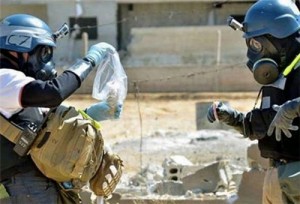 When chemical-weapons experts work with things as dangerous as mustard gas and sarin, they don't like to be rushed.
When chemical-weapons experts work with things as dangerous as mustard gas and sarin, they don't like to be rushed.But a fast timetable is exactly what the United States and Russia have agreed for Syria. The deadline of mid-2014 for destroying all of Syria's chemical weapons is the fastest schedule ever attempted, anywhere.
No wonder, then, many chemical-weapons experts are wondering what form the disarmament effort in Syria will take. And in the absence of details from Washington or Moscow, many assume the approach will have to be both extremely flexible and even unorthodox.
"I cannot see this go through the traditional orthodox process of setting up a destruction facility [in Syria], commissioning it, testing it, and then destroying in a systematic manner the controlled stockpiles, because that would take years," says Rolf Trappe, an independent chemical-weapons expert based near Geneva. "You can't really do that within a few months."
Trappe, formerly a scientist at the Organization for the Prohibition of Chemical Weapons (OPCW), believes the disarmament efforts will probably have to use multiple methods.
But he says predicting which specific methods is difficult because weapons specialists must first get full information from Damascus as to the types, sizes, and locations of its chemical-weapons storage and production facilities.
Washington and Moscow have agreed that the Syrian government should provide this full accounting within a one-week deadline once the UN passes a resolution ordering Damascus to give up its chemical weapons.
Mass Transportation Elsewhere?
One method could be to transport stockpiles out of Syria for destruction in sophisticated incinerators in Russia or the United States. But that choice is complicated by the fact that Syria remains in the middle of a conflict and transports would be vulnerable to attacks.
Former UN and OPCW Inspection Team Leader Dieter Rothbacher sees removing material from Syria as a limited possibility.
"Can they be transported [out of Syria]? In principle it is possible," he says. "There are special containers in which you can pack the munitions, you can transport them, but I think logistically that is probably even more difficult than just to destroy them on site."
Still, destroying chemical weapons within Syria also poses major challenges. To destroy large stockpiles requires both constructing an incineration facility within the country and bringing materials to it locally. Each is difficult to do unless there is full cooperation from not only the Syrian government but also rebel groups to guarantee security.
Trappe says a better solution might be to bring mobile incineration facilities into Syria from outside and use them to destroy smaller target stockpiles. Other materials, particularly stocks of chemical precursors, can be disposed of by showering them with water under special conditions to disassociate their molecules.
But Trappe does not rule out that, in some cases, disposal experts may have to settle for simply disabling chemical weapons because they may not be able to actually destroy them safely.
"You can certainly use techniques to disable the weapons so that at least they can't be used at this point in time," he says. "If these are filled chemical weapons where the agent is in, for example, a rocket warhead, you can disable the thing so it cannot be fired, you can cut through the engine of the rocket. So I think people will have to use a bit of imagination to create a situation where you can eliminate the stockpiles at this point in time, while then there may still have to be some additional work later on."
"Later on" would have to be when Syria's security situation stabilizes sufficiently to permit a better alternative.
Balancing Best, Worst Practice
All of this means that the expected chemical-weapons disarmament effort in Syria may have to fall somewhere between best and worst practice for disposing of these lethal substances.
Best practice is to have lots of technology and lots of time available -- the way, for example, the United States is currently destroying its own stockpiles. The process has been going on for the past 28 years and is still not over as the chemical weapons are destroyed in special furnaces that also filter out waste products so they do not enter the atmosphere.
Worst practice is using makeshift solutions -- the way, for example, the United States rounded up Nazi Germany's chemical weapons and buried them at sea, or the way the UN inspectors sometimes burned Iraqi chemical weapons in open pits. Both sea burials and open-pit burning are considered out of bounds today.
The only certainty about Syria is that world powers are not likely to consider any schedule beyond that already set in the framework agreement between Washington and Moscow last week.
Western states remain determined to hold Syrian President Bashar al-Assad to a tight timetable in hopes of assuring that chemical weapons are not used again in Syria's nearly three-year-old civil war.
UN inspectors said on September 16 that they have "clear and convincing evidence" that chemical weapons were used "against civilians including children" during an August 21 attack near Damascus.
The UN inspectors stopped short of saying who launched the attacks, which Washington blames on the regime but Moscow blames on rebels.
By The journal of Turkish�Weekly
The Iran Project is not responsible for the content of quoted articles.










